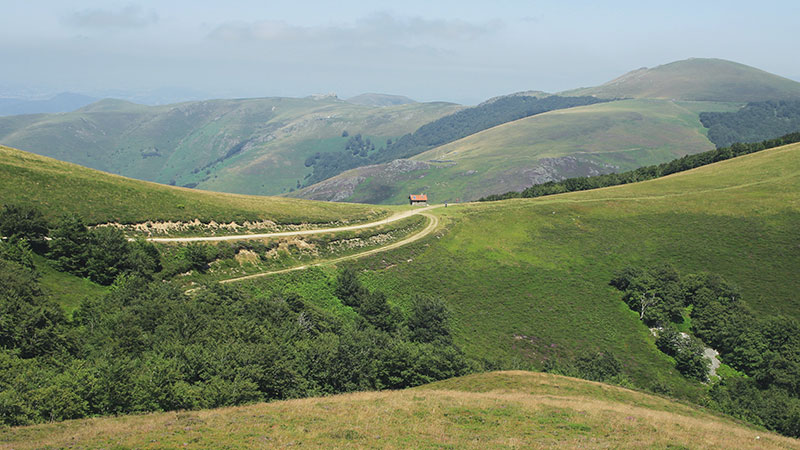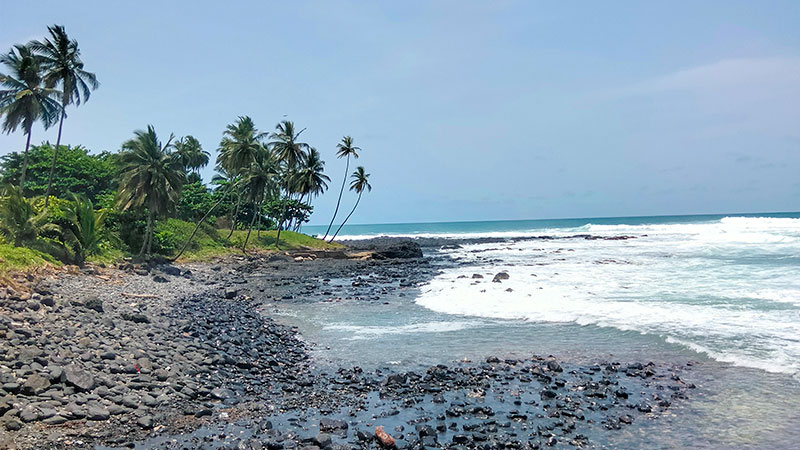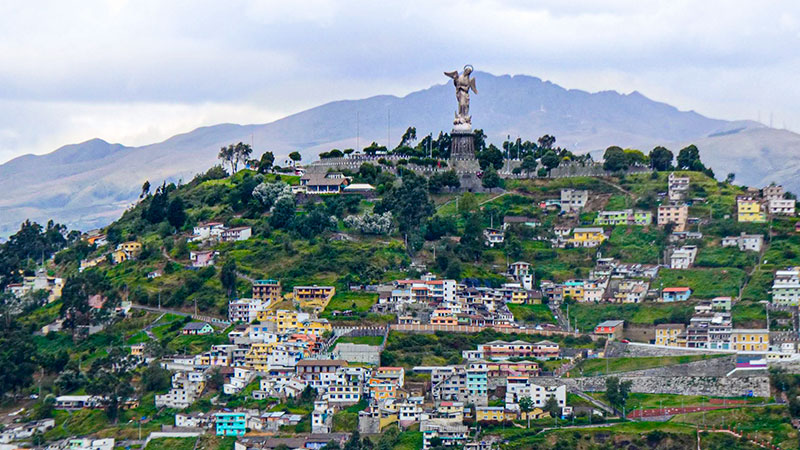NOTES FROM A HAPPY TRAVELER
São Tomé and Principe: A Travelogue
By Pilar Molina | April 2-9, 2022
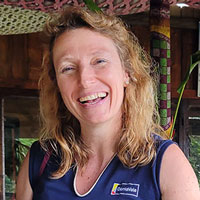 A Different Travel Concept
A Different Travel Concept
Maria’s Travel—exploring nature, history, food and culture—is a different travel concept where you are immersed in a global experience that includes:
- Respect for the environment, flora and fauna
- History, to help us to learn where we are, and the country’s evolution
- Local foods
- Traditions, folklore, handcrafts, etc.
- Interaction with local people. For sure, the most important experience when traveling.
Why São Tome as My Destination?
Just curiosity. Curiosity makes us go forward and discover life itself. São Tomé and Principe is the 2nd smallest country in Africa. It is a volcanic island located in the Gulf of Guine, close to the Earth’s equator. The country is comprised of two main islands, São Tomé (50 Km x 32 Km) and Príncipe (16 km x 6 km).
There are also a few nice islets such as, Ilhéu das Rolas, Ilhéu das Cabras, Ilhéu Bombom, Ilhéu Caroco, Big Tinhosa and Small Tinhosa. Among these islets, the emotion and energy of the 0° latitude at the equator becomes pretty real when you can step on both on northern and southern hemispheres at the same time in Ilhéu das Rolas. This territory belonged to Portugal until July 12, 1975 when it became independent.
Day One | Welcome
You can reach this country directly from Lisbon, Portugal after a six-hour flight and 4,676 km. The flight offers an aerial view of Portugal and Spain (Extremadura, Andalusia, and Mulhacen Peak whose elevation is 3,479 meters above sea level), the Mediterranean Sea, Algeria, Niger, Nigeria, and the Gulf of Guinea. When approaching São Tomé, you can enjoy the view of a very green island surrounded by a “multi-blue” ocean caressing the coast.
Sâo Tomé International Airport is small. After landing, we walked down the stairs to the terminal as there are no jet bridges. We immediately felt the typical hot and wet tropical climate on our faces. Due to anti-Covid-19 procedures, passengers were received in a tent where all the documents are checked. Do not hurry; this is an important point, because here you start your leve-leve, island-time vacation.
We were welcomed by our local tourist guide who drove us to Hotel Avenida in Sâo Tomé, the capital city, where we spent our first night. Sunset is at 17:30; we can enjoy sunlight for twelve hours.
Our first contact with the pace of this latitude was a relaxing swim in the pool after the hotel check-in. Later, we met a group of Portuguese tourists and N.G.O. volunteers having dinner at the Papa Figo restaurant. We tasted Calulu, a type of stew, popular at events and family celebrations.
After dinner we wanted to go dancing at Casino, but a private event there made us choose a new dance venue, Mami. It was a great option, for we could feel the authentic atmosphere created by local music, and felt welcomed to share with them and dance a few African pieces, even if it was our first time. The people are very kind and help you achieve a successful performance.
Outside these places, groups of young people meet among bikes, cars and street food stalls, providing the color and the sounds of this part of the city.
There are six districts in São Tomé and one in Principe, comprising the two provinces of the country.

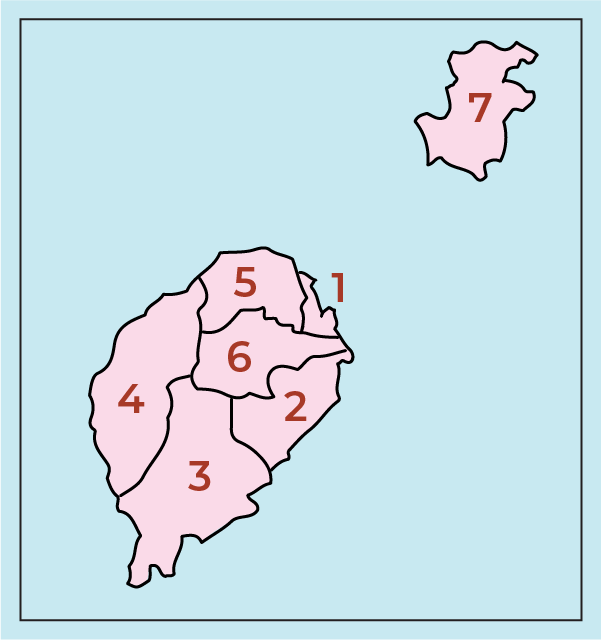
Day Two | Today We Go North
We started in São Tomé city, in the Agua Grande District (1). We drove to Guadalupe, the main city in Lobata District (5). On our way we discovered Santo Amaro Town and Roça Bela Vista (banana plantation). Roças are large farms or plantations where, the manor house, workers’ houses, hospital, chapel, school and lands are inside the perimeter, like a small village.
Next, we passed through the towns of Micoló and Fernão Dias on the coast. There, we stopped at the Monumento Mártires da Liberdade, erected in 2016 in homage to the victims of the Batepá massacre. It was impressive to see the names of so many deceased people who fought for their freedom rights.
Then we left the coast to discover Roça Agostinho Neto. It is the largest and most important farm for cocoa cultivation on the island. Here we had a guide who lived in this place. He accompanied us to discover “the now. To know what “the before” was like, a person who lived there as a child during the colonial era was with us. That visit gave us a vision of how people lived before. It seemed that we had entered a movie set.
The first thing is the amazing magnitude of the Roça. You cannot see its full extent with your eyes. There are different buildings, with a train to take products from one place to another within the Roça.
Among the premises, we find the most important hospital on the island during the colonial times, which is now abandoned and in very poor condition. Not far from the hospital, we entered one of the few colonial buildings that is well-preserved and still in use: the chapel, Capela Nossa Senhora do Carmo, with its Baptismal basin on the left side.
The Manor house, which is not in good condition, is lived in by various local families. The cultural hall can be visited, a place where parties where thrown and meetings took place. The original ceilings, floors, furniture and wall ornaments such as turtle shells, are remarkable.
As it was Sunday, there was a very familiar atmosphere. Local families were together having lunch in the shade of the trees next to the chapel. We were offered to share the moment and meals with them. And of course, we cannot forget we were in Africa, and music surrounded us…. rhythm is part of their DNA. Great!
The building where former workers were counted before and after their shifts, is now a kind of cultural center for workshops, handcrafts, and a women’s meeting point.
Once we finished our visit to Roça Agostinho Neto, our guide drove us to Guadalupe town (7,604 inhabitants). Someone thought we deserved a rest…and there we were, at Lagoa Azul, a small bay in the northern part of the island of São Tomé. This easily-accessible beach, both by road and by footpath is a beautiful landscape with baobab trees and blue sea. I snorkeled next to the rocks and was able to enjoy the wonderful temperature of the water and the different fauna (fish that I had never seen before). Above our heads the lighthouse was visible from the distance.
About seamen—the traditional vessels are wooden canoes, usually with two men on board and one long oar. When the wooden hull becomes less hermetic, the task of bailing out begins. Nothing stops these sea professionals. Sailboats are rarely seen. I saw one from afar, and I cannot clearly describe the features of the hull. The guide told us that the sails were made from rice sacks. Incredible. I understood that the art of sailing was exactly that: An Art with capital letters.
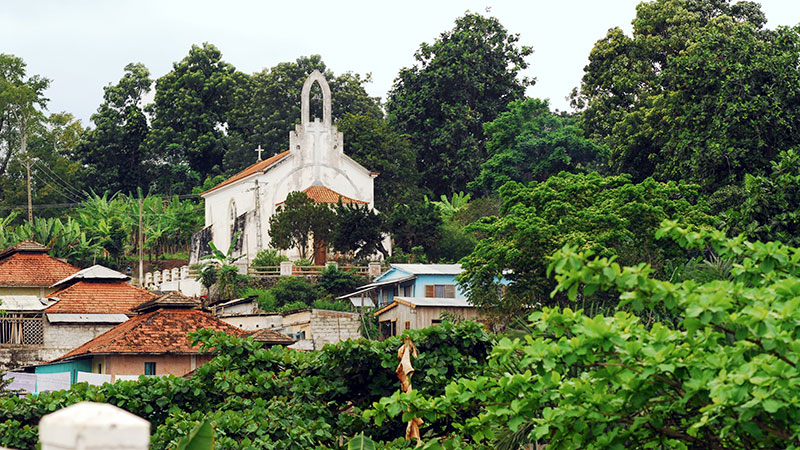
The church at Roca Agostinho Neto.
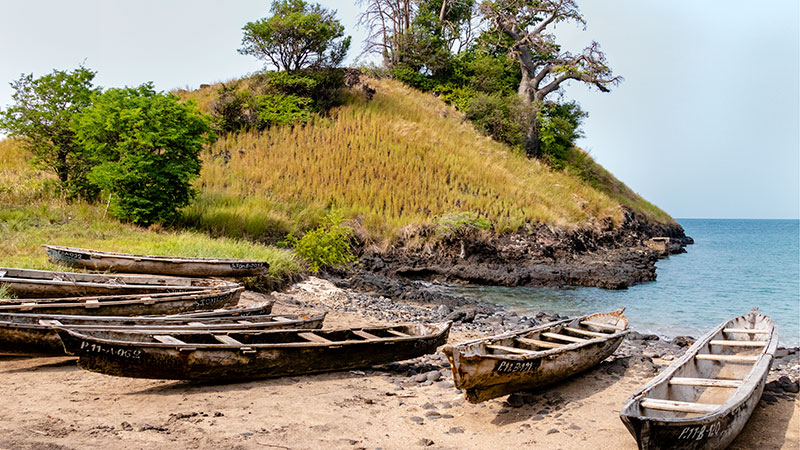
Fishing canoes at Lagao Azul
Our next District was Lembá (4) with its main town, Neves.
We stopped at the Mucumbli complex with its ecological hotel and restaurant, located in Ponta Figo, Neves. This environmentally-friendly facility is respectfully built from stone and wood. The restaurant terrace is amazing. Its balcony invites you to contemplate the symbiosis of the sea and the flora in shades of green.
In addition, there is a relaxing area with sun loungers and other places to have a drink and enjoy a chat. Good service and very good food. There are places that you would like to take with you in your suitcase, and this is one of them.
Afterwards, we visited another icon of the island, the Santa Catarina Tunnel, which is the only tunnel on the island. It was a very complex engineering project due to the orography of the place, and the technology that was available at that time. It was carried out by the Portuguese Engineer Galvao in the 1960s. Until then, it was not possible to tour the whole island without travelling by boat to access the other part. Thanks to this civil engineering work, we can enjoy the entire route by car. I suggest when you are next to the tunnel, look for the Cossack’s head. Photos with the tunnel are very nice.
After a photo session in all the places we had driven by, we went to rest at the Residêncial Tamarindos in Morro Peixe, District of Lobata (5). The first owners of the house were workers from Roça Agostinho Neto. Residêncial Tamarindos is a hotel in which bamboo furniture (beds, shelves) and stone floors stand out. It is the beauty of simplicity. It has a large terrace surrounded by a mosquito net, used as a dining room. There is also a wonderful and spacious terrace with two fabric hammocks evoking the colonial style. Of course the view of the garden is to be enjoyed. The breakfast is delicious with a large variety of fruits. The kindness of the staff was superb. All pros, with only one con, dealing with accessibility: stairs, the cobbled floor, and difficulty getting out of the bed due to the double bamboo cane surrounding the mattress.
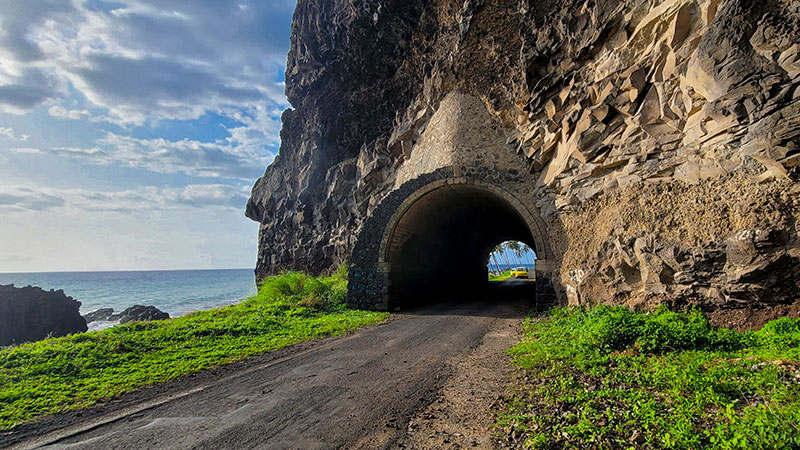
The Santa Catarina Tunnel, was built to allow access by car to the rest of the island.
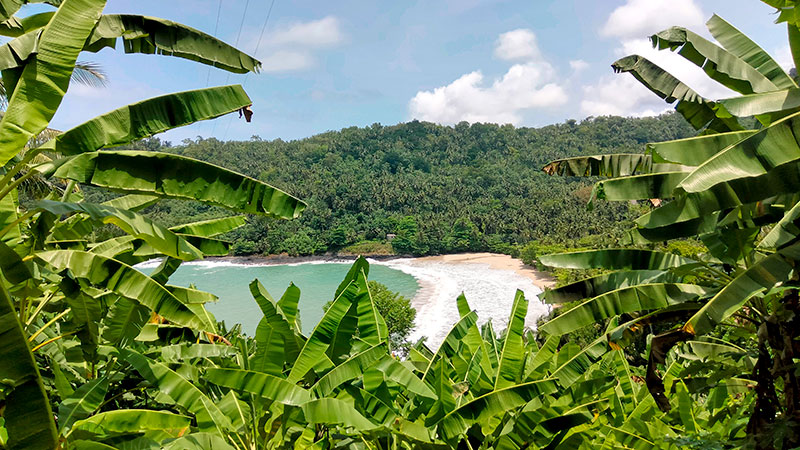
Beautiful inlet on Sao Tome.
Day Three | Today We Go South
We checked out very early. We left the Lobata District (5), and passed through the Água Grande (1), Mé-Zóchi (6), Cantagalo (2) Districts, to finally reach the Cauê District (3). That is, we have to go back on our journey and through São Tomé again. Once we crossed the city, we drive along the coast towards the south. The first kilometers were faster and easier. Although the journey was not that long, its layout and road conditions made travel slow, which gave us time to appreciate the details of the landscape, the stares of the people we met and the laughter of the children.
We passed through the towns of Água Arroz and Bombom and reached the District of Cantagalo. Santana is the largest city in the district, with 10,290 inhabitants. Do not miss its church by the sea. We continued and passed through the Roça Água- Izé, which was the first community to introduce cocoa.
We took a short rest at the Barão de Água-Izé restaurant, then continued along the road, heading south. From then on, the road was fun because of the curves and later on, the road became unpaved and bumpy. This is why, the road to the south is less busy.
We drove through Praia das Sete Ondas and the towns of Ribeira Afonso, Santa Cecilia. We saw the Ruins of the cocoa dryhouses next to the road, the Praia Micondo and in the background, the María Fernandes mountain. We also went by the Agratoldo farm where palm oil is extracted and fruits ready to be processed can be seen. We arrived in the Cauê District where São João dos Angolares is the most representative and important town.
Going on along the road, there is a place from where the Pico Cão Grande, a representative peak of the island with a phallic shape, can be seen very well.
We crossed the Rio iô Grande, the town of Dona Augusta, entered the Ribeira Peixe. We passed by Praia Grande, the town of Monte Mario and crossed the Malanza River arriving at Vila Malanza. Next to the road we saw Bar Restaurante N´Guembú (beach resort). Although we did not stop there, I wrote it down to visit another time.
We arrived at Praia Cabana. There we had a swim and drank coconut water offered by a 9-year-old boy who wielded a large machete with ease, and also offered us shells from the beach. I have learned that one should not “take” shells or stones, from the natural environment even if it is wild because shells are necessary both to create those beaches, and for many animals. We are on the side of respect for nature because we are part of it, and we need each other. Here in Praia Cabana, there was a modest restaurant with typical and very tasty food.
After lunch, we were surprised by the noise of a powerful engine on wooden boat reaching the shore in our direction while waiving a few life jackets for us. Once on board, the waves and the boat-pilot (…he sailed so fast over the waves…) became the real protagonists. That man had absolute control of the area with its reefs, riding waves at high speed. He made a very funny trip heading to Ilhéu das Rolas. (Honestly, an islet I didn’t even know existed until then). But as I said before, the simplest thing contains a surprising treasure. A treasure in an islet…? we have already watched the film…haven’t you?
(As usual, as if in a treasure hunt, we followed the instructions…) we landed on the beach, went through a village full of life: children playing, domestic animals in the streets, women carrying baskets, men playing cards. I concentrated on looking for the “hidden clues”. Not found, we went on walking up the slope, which became harder and harder. On the top of the hill we happily found a path, at the end of which, opening to an esplanade, there was a sort of large terrace overlooking the ocean. Many people playing the same game, but we had no more clues, not even a map. Oh, yes, it was there! We were walking on a very large mosaic map. Now it would be easier.
Disappointed, because I could not find on the map the location of the treasure with the typical “x mark”. Just a moment later, we realized that the treasure was already is in the middle of that esplanade, beneath us and could not be marked with a single “x”, but with a line: the Equator Landmark (latitude 0°).
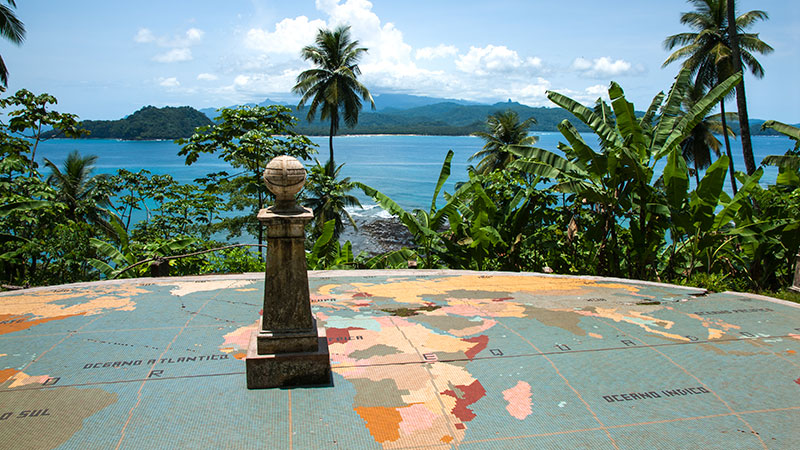
A map on the ground demarks the equator at 0° latitude.

View of the Pico Cao Grande peak.
It was very special/emotional stepping on that line that represents the equator dividing the hemispheres into north and south. I can’t explain it, I just felt a very strong energy, vitality. I admit that I was excited; it was the expression of the overflowing joy of stepping on such a special place. I took many photos, but I also spent a few minutes thinking, praying, and giving thanks for being there. It is a place that invited me to introspection. I would have liked stay there a little longer; I felt connected there and didn’t want to leave.
A comment for this place: You only have to pay for the boat rides, because the access to the monument is completely free.
While strolling through the village again, we noticed that garbage was accumulated in certain visible zones. We thought of some ideas to implement. Hopefully in a few years, this situation will improve. The ride back on the boat was also a lot of fun, although it seemed shorter. I could not hide my satisfaction. Wow!
Later, just before sunset, we arrived at Hotel Praia Inhame Ecolodge. It is an ecological bungalow complex in which the cabins are all made of wood and the environment is protected. There is a stone path leading to the reception and restaurant. The restaurant is on the beach and the landscape is similar to postcards or romantic movies. Then, we sipped a drink to enjoy the sunset and celebrate that wonderful day. We also tasted a wide variety of foods in the restaurant buffet. Very good quality, perfect presentation and excellent staff.
After enjoying our dinner and a pleasant conversation, we went to our cabins. I love swimming by night, but I was advised to not to do so because of the crabs. I am not afraid of crabs, but on our way to the bungalows, dozens of scared running shadows disappeared towards the sea. That made me consider having a shower instead.
Our wooden cabin was called Jaca. A few steps to access the entrance with a wide living room (with extra bed on demand) a very spacious main room, another double room and two bathrooms. Perfect for four or five people. All the windows were protected with mosquito nets. The terrace around, and a paradisiacal view of the ocean and surroundings of the hotel.
Day Four | Back to São Tomé
A pleasure to wake up early? Yes, sure. What is better than feeling the breeze, taking photos while walking barefoot along the beach at dawn? (And the crabs were sleeping).
Although the weather is unpredictable, with the only observation of the birds’ behavior (flights and squawks), we knew that it was going to rain. Soon, it rained cats and dogs. It was not long, but was dangerous for swimming because of the electric component. The storm had dragged wood onto the beach; more coconuts had fallen onto the sand; and in a few minutes, the image of the beach had changed completely.
Breakfast with a wide assortment of delicious fruits, buns, etc. We check out and were ready for a new adventure.
Before arriving in São Tomé, we visited Praia Piscina. It is an original beach with rocks that form very calm natural pools. I recommend wearing water shoes. As the storm was recent, the color of the sea was darker, but the temperature of the water was still very good.
Then we went to visit Praia Jalé, which is a very special beach because turtles go there to lay their eggs. You can see the holes they make in the sand. Did you know that the gender of a turtle depends on temperature? Females need a higher temperature. Tatô Program is in charge of the protection, conservation and study of the sea turtle populations of São Tomé. This program is spearheaded by an elder that started by using turtle shells to do jewelry to sell as a young man. He began to understand the negative impact on the turtle population, rapidly changed his ways and started educating those around him.
After the turtle beach, we went to Vila Malanza. Being so far south of the island and due to the poor communication infrastructure, the acquisition of resources and products is more difficult and almost non-existent. We were told to bring the educational material we had collected before the big trip. So we went to the school, but arrived a bit late as the children had already gone home (12:20pm).
One of the lady teachers received us and showed us the premises. Only a look at the access to the school makes us think how lucky our children are. The school comprises two small simple cement houses. The first with 79 children between two and five years old. The other house is for children over six until they finish primary school.
With a hearty wide smile, the three ladies in charge of the education, very kindly explained to us what they do. They showed us the classroom and the room where the two-year-olds are cared for. We handed out the material we had brought and they welcomed it very gratefully. A magic and touching moment. A mixture of emotions kept in my heart.
The child and adolescent population is very numerous in this country. Education now is important. While walking through the towns we can see children wearing a red and white checkered gown (these are the children who are in kindergarten). Those in primary school wear light blue gowns. And high school teenagers wear a navy blue skirt or shorts and a beige shirt with stripes on the shoulder indicating their academic year. São Tomé city is the only place with higher education and a university.
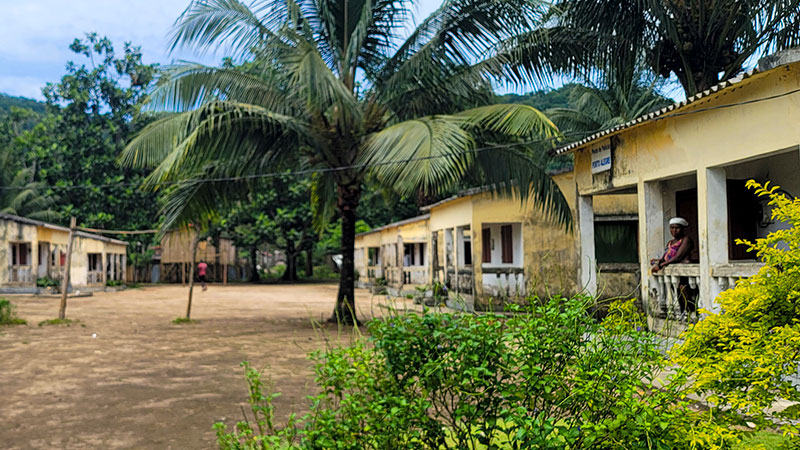
A town visited along the way.
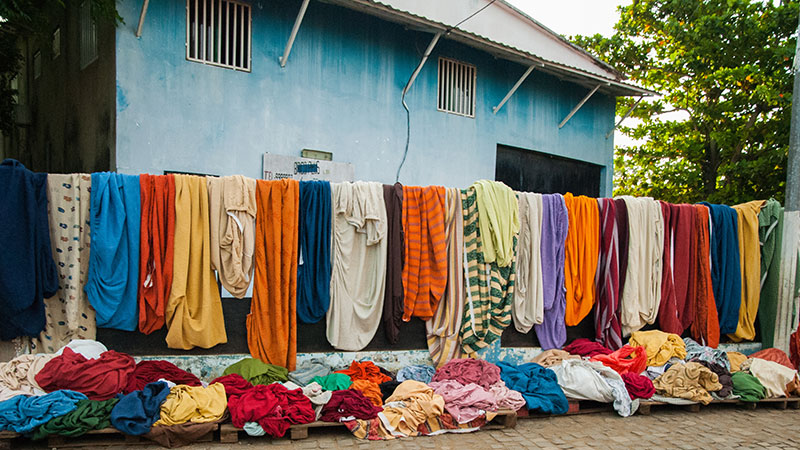
A row of colorful cloths hangs at a market.
We followed the reversed itinerary of the previous day. This time we had lunch at Restaurante Miónga. It means “Sea” in Creole (the local native language). It has a fabulous view of Praia São João dos Angolares. There is a large staircase leading down to the restaurant (so access is not adapted for people with reduced mobility). In addition to the restaurant, the facilities include a large garden with statues and views of the beach. They also have an exhibition room of handmade woodcraft. It is a charming place with a very good menu and service.
Next to Praia São João dos Angolares, there is a fishermen training center where we could see more closely the canoes they use.
We visited the Roça São João restaurant which has a viewpoint and baskets with different kinds of colorful fruit on display. The RAM Museum is located there, with the slogan “We rock the world right here”. In addition to contemporary art paintings, there were works of art made after recycling other pieces of daily use.
Back to the car, we found a lot of young people and children running along the road towards us shouting “lula-lula”. We asked them what happened. In fact, they were running to the beach because in that moment of the day there were many squids. We went with them to see how they caught them. But unluckily there were no squids. The best of all was to see the children having fun on the beach and see groups of all ages go together, and how they seemed to take care of the others.
The atmosphere was so noisy and happy that we asked a group of girls for their permission to take some photos. They accepted under the condition that they would also like a paper copy of the photos. They were right and it was fair. One of my colleagues printed the photos and they were given to the children by our guide in the following days.
When we returned to Ribeira Alfonso, we were told that the famous Fiesta de San Isidoro is celebrated there and it is so important that people from all over the island meet there. The great day is on January 10th.
On the way back to São Tomé, we went to the “Sweet Guest House” the hotel where we would spend the rest of the nights. Its wide and cozy terrace is suitable for resting after an intense day of travel. It is a well-run hotel that fulfills all your needs. Delicious and complete breakfast. There is no swimming pool. Very good customer service. The hotel owner, showed us their new business line producing their own chocolate. Fantastic.
That night we went to have dinner at Restaurante O Pirata next to the bay of São Tomé. It was a busy place full of tourists that can wait for a long time to be served. It is a very well-known restaurant.
Day Five | Today We Go to the Interior of the Island
There are three main roads. Today we took road #3. We headed towards the city of Trindade (Trinidad). It is the second most important city on the island in terms of population, with 16,140 inhabitants (2012 census). It is the capital city of the Mé-Zóchi district (6). Because of its humidity, it is an area with a great agricultural production. This is where the São Tomé orchard is concentrated.
We drove by Torre Dias, and the Valudo factory, which produces coconut oil, and Quinta da Foronta (which is private) before arriving in Cidade da Trindade.
In Trindade, founded in 1779, the influence of the Claretian missionaries is evident. The colonial Trindade Church stands out, on the top of a hill, overlooking the landscape. It has also an important market and the Maria Manuela Margarido Secondary School with capacity for 720 students (it is the second largest). There is also an agricultural training school.
It is important to pay attention to the Monument of the Bate-Pá Massacre. On February 3, 1953 at the command of former Portuguese Governor General, Colonel Carlos de Sousa Gorgulho, the Portuguese landowners unleashed a wave of violence against native Africans. The idea was a program of public construction and improvements, resorting to constant raids on native populations in order to get cheap or free labor. More than a thousand people died in this rebellion. Every February 2nd, at night it is commemorated with candles.
We passed through Villa Pedro Mateus, which is typical because of its palm oil production. We went to the Roça Monte Café where coffee is produced and sold. We visited the Coffee Museum where we learned about the production and elaborate process. All this immersed in an impressive atmosphere of full aroma as they were roasting coffee.
All the Roças have their own population, with their school, etc. They were also selling sugar cane. It is great: delicious coffee and sugar (cane).
Later, we went to the Jardim Botanico do Bom Sucesso, which is the gateway to Parque Natural d´Ôbo. It was part of Roça Monte Café. The botanic garden guide, was very kind and friendly, he told us that the park has more than 400 species of endemic flora and more than 1,000 samples of plants. There is a very beautiful area where different varieties of orchids grow. Let’s say that the Jardim Botanico is the pharmacy of São Tomé.
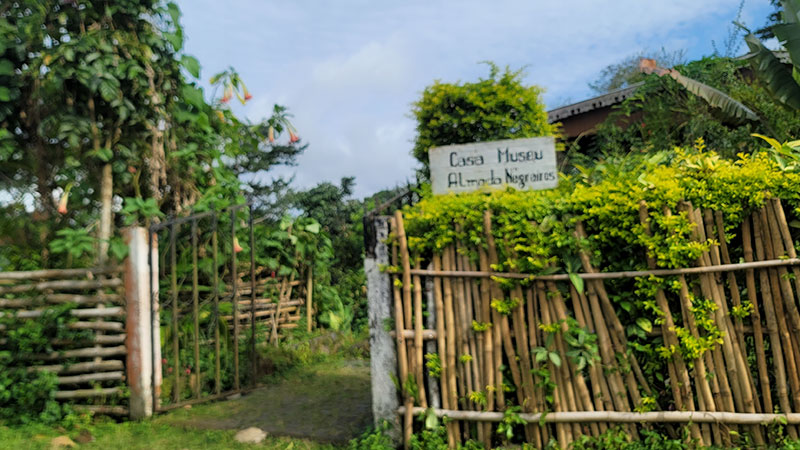
A bamboo fence at the entrance to the Casa Museumo.
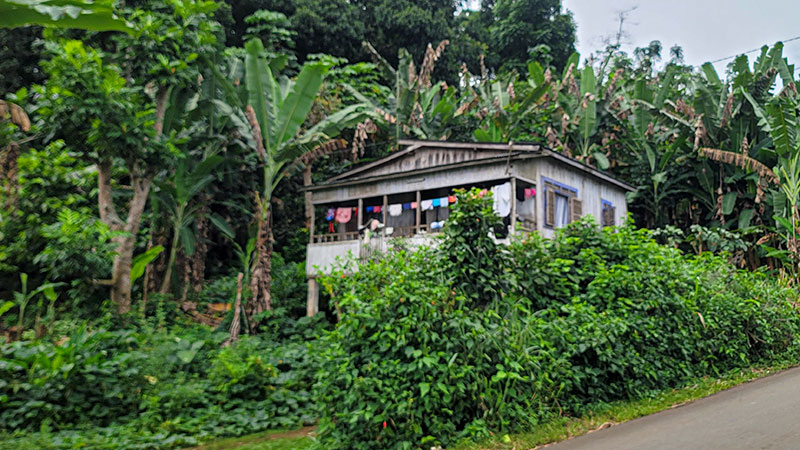
A quaint residence amid palms and other vegetation.
From there, we headed to the Cascata de Sao Nicolau. It is a 30-meter waterfall located in the tropical jungle of the island. You can walk into the small lagoon but the water is very cold and it is dangerous to be near the water falling. It is a wonderful, secluded place with only the sounds of birds, and as you approach the waterfall your worries are silenced. It is a time of clear thinking and gratitude for the wonders of nature, a place to contemplate and spend some time with yourself.
Then we went to Roça Saudade, where the Casa Museu Almada Negreiros Restaurant is located. As soon as we arrived, there was a group of children offering us the fruits they had collected (raspberries and other small fruits) in very good-looking natural leaf cones. They had also made a beautiful bouquet of flowers. It was the most beautiful I have ever seen. The children, always smiling with naughty and pure eyes at the same time, were so lovely.
The restaurant is situated in a beautiful setting. The decoration, as usual, wood and reeds. The very delicate details (handmade tablemats), fabrics on the ceiling coloring an already colorful landscape. The restaurant is on a terrace with a spectacular view of the tropical forest. We tasted typical dishes with a perfect presentation. All delicious and excellent.
This museum house was built on the ruins of the house where José de Almada Negreiros (a painter and writer of the 20th century) was born. The restaurant is also decorated with some of his most famous quotes “Joy is the most serious thing.”
On the way back to the capital, we noticed how traffic was increasing a few kilometers from the urban area. Black license plates with white numbers are private cars. White plates with black numbers are state cars.
Our guide told us that the minimum wage can be around €45/month. An average salary (for example, a primary school teacher) is €150-250/month. Directors have higher salaries, and politicians, even more. In fact, it is striking to see wooden houses by the roads, the ones used by the local population, which are very simple, next to a well finished, painted, concrete chalet with a garden.
Again in São Tomé, we went to have dinner at Praia Gamboa Restaurant. It is a simple restaurant with a plastic roof, where local people go. Grilled fish is the main menu. Wonderful. Not only the tasty fish, but also the good and traditional atmosphere.
Day Six | São Tomé City
São Tomé City tour. The surroundings of Côco Market (the central market) are the heart of the city. Next to it the Taxi Square where taxis and moto-taxis queue. The taxis are yellow and show a sign with their destination. People interested in that destination get into the car, which will start the trip once all the seats are taken. If you prefer a faster service, motorcycle taxis are your best choice. There, you can also enter the Fardo Market (second-hand clothes). In that zone you can get the feel of the real atmosphere of the city. Visiting a market is interesting anywhere, because you get to know new food, aromas and a lot of color. Meat and fish are found in another market far from the city.
On the ground floor of Côco Market, tropical fruits and vegetables are sold, along with many kinds of herbs used for cooking and relieving ailments, and other kitchen tools and utensils, such as a coconut grater, etc. On the upper floor, there is a corridor with small clothing and shoe stores, with very colorful African designs. Wooden products (furniture, masks) and wood crafts are found everywhere.
We visited the Cathedral of Nossa Senhora da Graça, which faces the city’s bay. The original church from the 15th century was reconditioned in 1956 and the façade was significantly altered. The Colonial-style and painted-in-pale-pink Presidential Palace with its two soldiers at the gate is close to the cathedral. No photos allowed. We also saw the Central Bank and the Ministry of Justice.

Pink presidential palace.
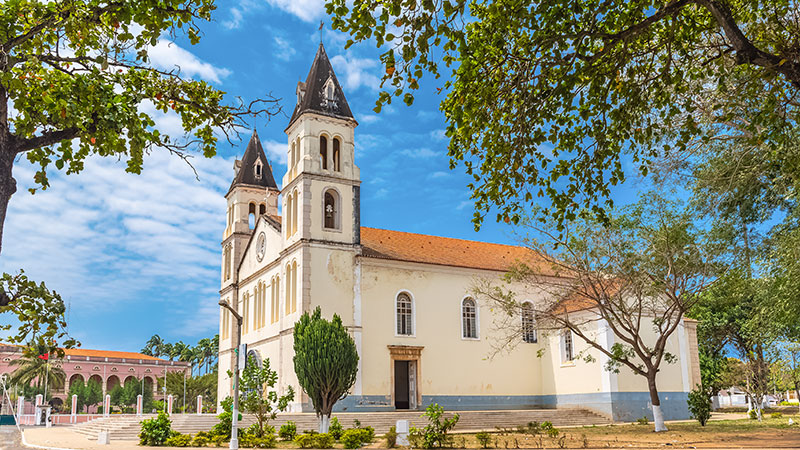
Cathedral next to the presidential palace.
A prominent place in the city is the Forte de São Sebastião. Built by the Portuguese forces in 1575 as a fortress against Dutch and French pirates, it was the first defensive building built in Santo Tomé, and was later rebuilt and expanded. The fortress is named after the Christian Patron Saint of Warriors, Saint Sebastian.
Inside the fortress, is the National Museum of São Tomé and Príncipe. Colonial furniture from the old Roças and sacred art are shown together with a thorough timeline through the different historical periods of the country. Do not forget to enjoy the panoramic view of the bay.
We had lunch at Restaurant Cacau, House of Arts Criançao, Ambiente Utopias. The Cacau building dates back to the early 20th century. It was built to house and provide maintenance services to the first trains that the government was running to connect the city of São Tomé with the surrounding areas, such Trindade. It is a former warehouse, dedicated to historical exhibition, with some meeting rooms. Now, workshops about the threat of plastics are held here. If no action is taken, it is estimated that by 2,050 there will be more plastic in the oceans than fish. They make bags and other decorative elements with the collected plastics.
Afterwards, we drove around the city. Along Avenida Marginal 12 Julho, we saw colonial houses, some of them in poor condition. On Casa da Misericordia, we passed by Liceu Nacional (high school for 14-17 years old), Radio Nacional, a Casino, the Soccer Stadium, and the Francisco José Tenreiro National Library, and the Museum of Anthropology. There is only one cinema but it is out of use.
Then we entered the Mercado de Peixe (fish market) which is on the outskirts of the city. They have a wide variety of salted fish. Outside the building, there are women selling their freshly picked vegetables.
In the zone of Pantufo, we visited the Vanilla Museum. There is a small company producing vanilla, which is a type of orchid. The process requires very delicate work. But the best is to go to the museum and taste the incredible vanilla rum.
Going on with our afternoon, what else to expect? A simple visit to a chocolate shop. Disappointed? No, we were not! This heavenly place was called Diogo Vaz “Un chocolate unico feito no coração da nossa plantação” (A unique chocolate made in the heart of our plantation). A fierce struggle began between my mind and senses, and finally, my will was defeated. No words are available to describe my “efforts” to taste the different kinds of chocolates, chocolate and coconut ice creams (that was the high price of surrender).
In the evening, we went to the Chiringuito Paraiso dos Grelhados to relish a passion fruit drink called “caipirinha”. Later, at Lugesmar restaurant, we danced while waiting for dinner. (Caipirinha side effects? Who knows?) The fact was that we were very comfortable in this restaurant. Fish, meat, vegetables, rice, and excellent service.
At the end of the night, we went to the BBC, a very pleasant terrace where we could have a chat with other Portuguese tourists we had met days before at the Blue Lagoon.
Day Seven | Hiking Trail
We were ready. Today, we went on a small hiking trail (to compensate the chocolate “four-sided” effect? …No comment). It was a guided round trip that started in the Jardim Botanico and went to Lagoa Amelia (1.475 meters above sea level), three-and-a-half hours. The general information says as follows: “hiking trail; gentle slope at first that becomes more severe as you progress, mostly in tropical forest. The area is prone to fog and mist, and showers are not infrequent even during the dry season.”
In the beginning it was an easy narrow path, between crops, open areas and trees. Then the landscape changes and a landmark indicates that you are leaving that zone to enter a tropical jungle landscape, where trees grow everywhere, the humidity increases and the path narrows. The guide had to use his machete to open the way.
Sometimes the vegetation forms incredibly beautiful natural tunnels. The terrain is full of clay and very slippery, so it is recommended to wear appropriate footwear (trekking boots). You have to watch your step, with roots, leaves and branches everywhere.
We are in a paradise. I opened myself to that magnificent environment because I did not want to miss the slightest detail. Only three senses to enjoy all that information. When you enter the jungle you can feel the mixed smell of fresh wood, wet soil and mowed lawn; you can see the wide variety of vegetation, trees, bushes, 170 cm leaves, and birds; you can hear constant creaks when stepping on branches and the splash of some puddles, and of course, the symphony offered by the animals. Pure Nature! We took photos of some of the trees.
Although it is a wild place, there are people in charge of controlling the vegetation. They cut down trees that are not endemic to São Tomé and Principe. It is the best way to conserve flora and fauna.
The Lagoa Amelia is a lake in the crater of a volcano, located in the Obo National Park. It is covered by a thick spongy vegetal “mattress.” You must step carefully on certain places following the guide, otherwise, you can fall into the deep lake. Only one recurring thought in my mind: “as light as a feather, as light as a feather.” (A mantra for levitation?) It felt like a sort of stadium where the trees and bushes around were watching our performance crossing the lake. This is also another very special place to take a deep breath.
The last part of the trip was faster than we would have liked. It was very slippery and for a moment I thought of using one of the large leaves as a sleigh.
Back to the Botanical Garden, we signed the visitors’ book.
Along the way we met many peasants carrying sacks with their harvest to the sides of the road where they waited for a big pick-up to pile them and their products onto the back of the vehicle.
Afterwards, we went to theRestaurant Efraim, inside the Roça Monte Café. The restaurant is very well decorated, and you can enjoy wonderful views of the Roça and the ocean, with the silhouette of Ilhéu da Cabras in the background. Very good food, simple and traditional. Very good service.
What better rest than a while floating on the ocean? Like many of the young people of São Tomé we had the same choice. Since the water temperature was so good, it seemed like we were in a bubble bath enjoying the feeling that time stops there.
At night, we went to Restaurante Oduê del Rêi, a nice and simple place where we tasted another grilled fish called “côncôm”. The typical way of eating this fish is using your own hands. The place, the method, the fish and the staff were all a pleasure.
Later we went to a nightclub by the sea belonging to Hotel O Bigodes which became livelier with the passing of the hours. We listened to international music and some African music. We wanted to finish the night dancing even more, so we returned to the Mami dance room.
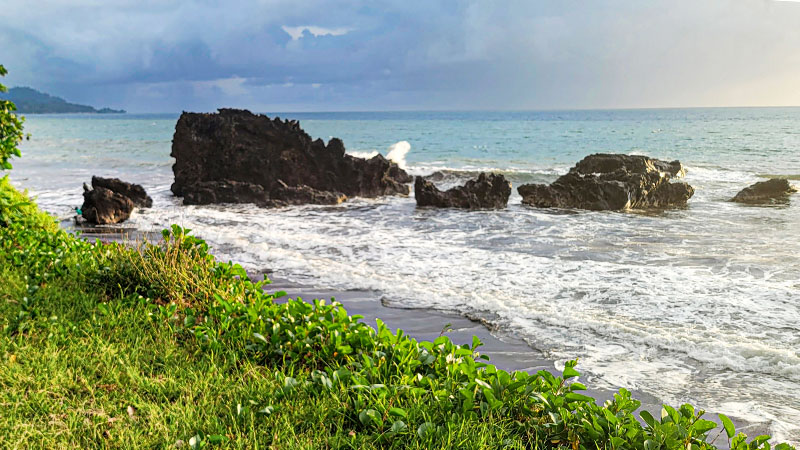
Rocks amid the white ocean surf.

Another gorgeous view of the sea.
Day Eight | Our Last Day in This Country
After checking out, we went and saw Tamarindos Beach, in the north of the island and not far from the airport. The day was cloudy, but our guide, very confident and cheerful, told me “just believe.” A few minutes later and on the way, a severe storm began (a typical one) but we continued the trip. Very close to the beach, we drove along some muddy paths.
It was impossible to access by car and walking was very difficult. The storm continued. I asked the guide and he told me “nature is like that, but you have to trust and have faith.” The previous plan was to spend our last day on the beach and have lunch there. A kind of farewell party.
The alternative plan was to visit Museu do Mar e da Pesca Artesanal. A place to learn about the strong connection between São Tomé people and the sea. Ancient fishing tools, gears, etc. used by them. We could see some of the most common marine species: turtles, cetaceans, birds, and a collection of vessels.
Then we went to the Tamarindos Restaurant where we had already been a few days before. We ordered calulu in advance, and we ate it there sheltered from the strong storm. We were told that the storm was unusual because it was a long-lasting one. But that day the dazzling sun after a storm had a break…a day off. The calulu was delicious and I felt like having something warm because of the conditions of the day. Up to 30 types of herbs provide the special flavor of calulu, which makes all calulus different.
It was the moment to say goodbye to our car drivers, who shared with us fantastic moments during the week. Very kind and professional people. As the weather was still stormy, we paid a visit to a Portuguese friend who has been living there for six years and who offered us her house until it was time to go to the airport. We were had a very good conversation but our hearts were somewhat sad.
We went to the airport. The flight was due at 22:00. The plan was a direct flight to Lisbon, but due to the features of the aircraft, we were told we had a connection in Dakar. After that unforgettable week, we did not mind what happened with refueling, the delays, etc. We landed in Lisbon at 09:15. Big smiles and happiness on our faces. A dream lived!
In Conclusion
Traveling to São Tomé has been a totally enriching experience because it has not only been going to visit a new place but, throughout this trip, we have been able to integrate ourselves into this country with its people, its culture, its gastronomy. When we return home, we will be aware of the fact that we have brought a little of this country in our hearts; and will have left a little of ourselves there. Those are the exchanges that move the world.
I can assure you that this country is a land blessed by God. In addition to a wonderful nature, this piece of paradise also has incredibly polite and hospitable people. They did not say goodbye to us, but “come back soon,” with real and sincere smiles.
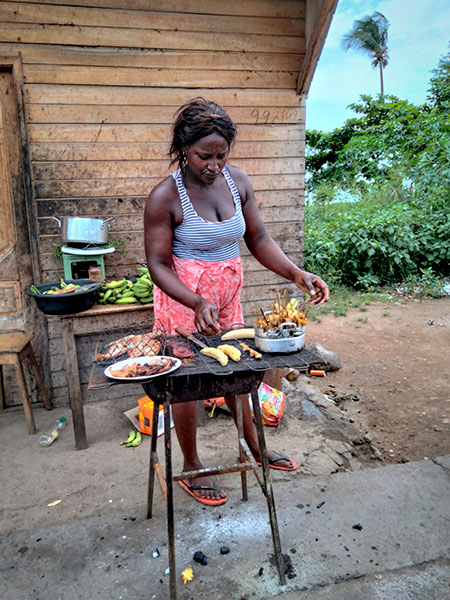
A woman grills fish outdoors.
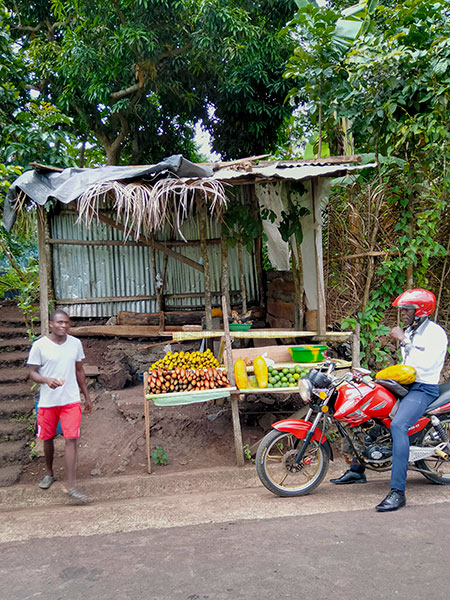
A boy selling wares on the side of the road.
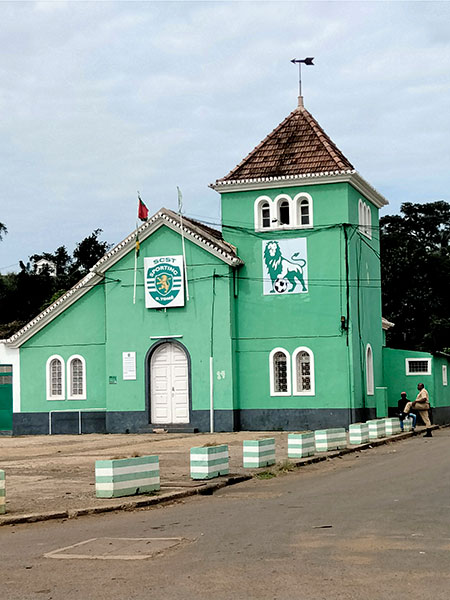
São Tomé Sporting Club
Special Thanks
My greatest gratitude to the person who made this trip possible: Maria João. She has offered me the opportunity to be part of her project and discover this wonderful, small and unknown African country. Pelila, for sharing the wisdom of her living experience, enriching the trips, the conversations and our friendship. I would like to thank Paula for her complicity in the most adventurous moments of the trip. The three of you have been the basement, the root, the soul, and the essential ingredients for this project. It is a pleasure to travel with you, people who are “beautiful at heart” and who make everything easy, even, when it is impossible to follow the plan. I have learned a lot from you and we have laughed a lot together. You are a gift from heaven!
I also cannot forget the local people who have been with us and helped us to discover the greatness of São Tomé:
- Luis Alfonso: Guide and collaborator of the trip.
- Sinpson: Tourist Guide and driver who shared with us many hours daily.
- Mr. Osvaldo: Taxi driver and great friend of Maria João
- Cileyde: Taxi driver for our cultural nights.
- Tomé: Botanic Garden Guide
- Ana: Our Portuguese friend living in São Tomé
And thanks to all those anonymous children, anonymous people, who only with their eyes and smiles have taught us so much about life.


